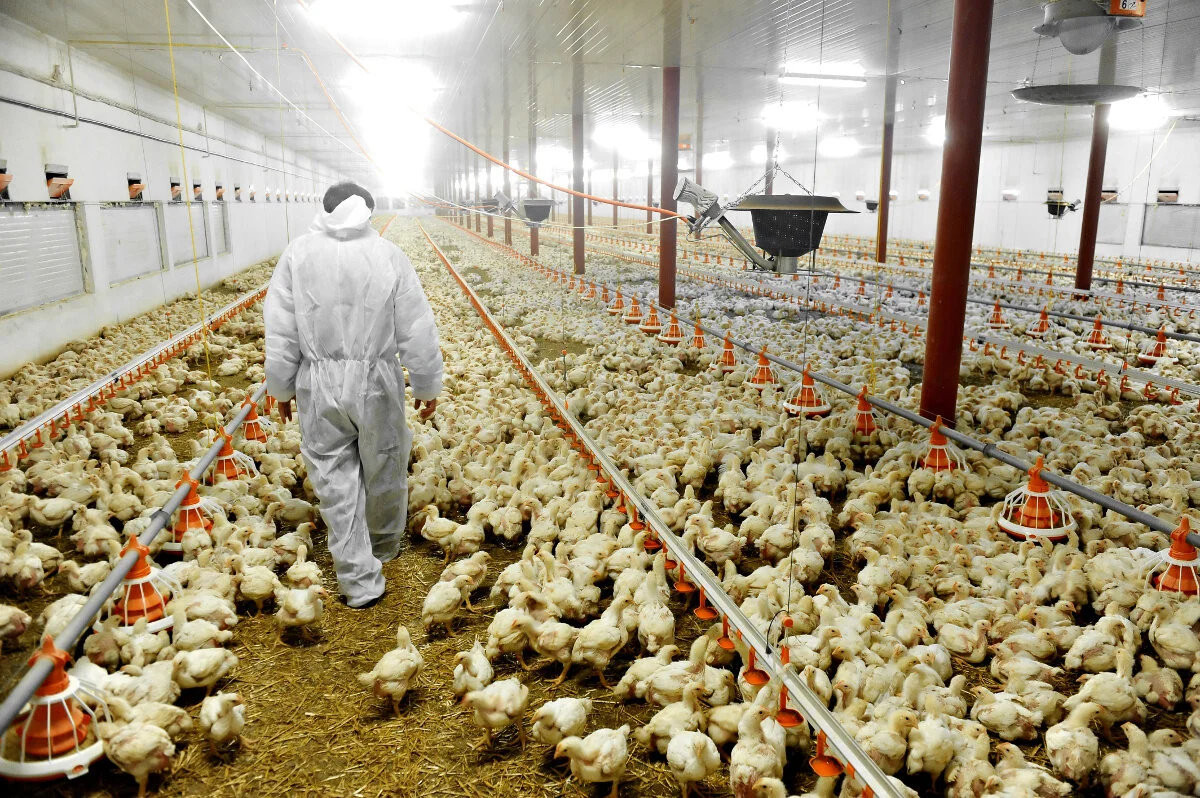Paddocks to Plates: Factory Farming
Written by Grace Hessian, Evan Choemuku-Huang and Lara Karunajeewa
Paddocks to Plates:
FACTORY FARMING
Factory farms are an often unmentioned part of our daily lives. Most people consume animal products on a regular basis and almost all of these animal products were produced in a factory farm, not the happy family farm that you were led to believe about. Eating plant-based foods and being able to avoid meats and dairy products is a privilege. Eating healthily and with the environment in mind is unfortunately not a choice that some people can take, due to socio-economic situations or other dietary restrictions and health problems. With that in mind, while reading this, consider how daily practices that we take for granted, like our meals, can be questioned. Our intention is not to force everyone to eat plant-based foods, but to encourage those who are capable to research how your food has an impact on you and the world around us. We will discuss three negative consequences of factory farming which are the environmental impacts, animal rights issues and health problems.
Environmental Impacts of Factory Farms and Meat Consumption
Despite the massive amount of animals housed so densely, there normally aren’t proper sewage treatment facilities, but rather many farms use the waste as manure. Since there is such an abundance of livestock, there is an inevitable abundance of manure which contaminates waterways with dirty runoff in rains and flood. Otherwise, the waste is stored in open-air lagoons lined with clay. The clay is susceptible to leakage and during floods or rains, the waste can contaminate waterways.
The agricultural industry, while not the biggest source of greenhouse gas emissions, they still emit a lot and specifically, a lot of methane. Due to its specific chemical shape, methane is much better at trapping heat than CO2 which means that small fluctuations in numbers have a big impact on global warming. In the atmosphere, there is only about 1,800 parts per billion of methane, but it is 28 times better at warming the Earth than CO2 so this represents a great risk. Beef is a very large contributor of greenhouse gas emissions, as seen in the image entitled Food: Greenhouse Gas Emissions Across the Supply Chain. Shown in brown is the amount of greenhouse gases will be emitted to make a kg of that product. Beef has an enormous share of greenhouse gas emissions and certainly much more than other animal products such as Lamb & Mutton and Cheese.
Land use is a major environmental issue when it comes to food production. Feeding and raising animals for consumption is very inefficient because it requires an immense amount of land, food and water. Globally, 33% of cropland are crops for livestock to eat. Projections show that so much food that we grow is fed to animals that if we fed all to humans instead, we could feed another 3.5-4 billion people. The graph titled Land Use Per 100 Grams Of Protein shows as of 2018 how much land must be used to make just 100g of protein. Lamb & Mutton and Beef (beef herd) is by far the most land intensive source of protein at 184.8m2 and 163.6m2 per 100g of protein. The six highest land uses of protein sources are all animal products. The highest land use that is non-animal product are nuts at just 7.9m2 per 100g of protein compared. The highest land usage among animal products (Lamb & Mutton) uses 23 times more land than the highest non animal product (Nuts) does.
As seen in the diagram Global Land Use for Food Production, of the land used for agriculture, 77% is used for livestock, including growing feed for said livestock. However, these animal products only make up 37% of the world’s protein supply with the other 63% coming from plant-based foods. Plant-based foods only make up 23% of total agriculture land globally. Raising animals is just too inefficient to be economically viable, now and in the future.
Animal rights
Before we begin discussing animal rights in factory farms, we would like to note that the following examples are certainly not the only major animal rights issues in factory farming and there are many others that we don’t time to discuss. For more information, see the plant based resources link at the bottom of this page.
Trigger warning for violence and animal abuse.
A very common argument cited against a meat diet is animal rights issues and the ethics associated with the raising and the slaughter of animals for consumption. Many people may exaggerate and twist these facts to their story, but the fact is that factory farming uses inhumane methods to raise and slaughter animals. Instead of seeing each animal as something with life that deserves basic needs such as adequate food, space and enough exercise, much like you and I, corporations see them as a commodity and a product, and the more they produce with the least amount of expenditure, the more money they earn. Therefore many methods are designed to extract the most value from each animal while ignoring their suffering.
One example is a process called ‘debeaking’. This is when the beaks of poultry birds such as chicken, turkey and ducks are cut off by a hot blade. This is because the poor lighting, limited space and unnatural feeding results in an understandable panic, and leads chickens to be confused and hurt each other. By cutting off the beak, the farms ensure that the chickens will not do any permanent damage to others, therefore keeping their commodity able to be used. How are poultry debeaked. When they are young, they are taken and a hot spinning blade is used to cut through the beak. Moreover, to save money, the debeaking process has to be done super fast in order to save money. Therefore the less trained farmers are under immense time pressure, and many cut the beaks really sloppily, more often than not cutting the lip and mouth of the chicken. If the blade is too hot, it can cause blistering in the mouth or burning of the tongue, which results in worthless hens for the industry. If the blade is too cold or dull, it can cause fleshy-like bulbs growing inside the mouth,
Another example is a process called ‘forced molting’. Natural moulting for poultry is when they shed their feathers and grow new ones. During this process, they are able to completely rest from laying eggs and are able to build up nutrients in the body. Forced moulting is when factory farms produce stress in the poultry in order to produce larger eggs which are more profitable. Usually this means either starving or giving them less nutrients than they actually need. Even with the animal rights issue, the eggs produced by chickens undergoing forced moulting may result in an increased risk of salmonella well. This only applies to the females. Males on the other hand are killed minutes after birth, because they are biologically not able to produce eggs, and they cannot produce enough meat to be economically viable. Therefore they are shoved down, not even dead but actually alive, these machines called macerators, which are basically huge meat grinders.
A third example is a process called ‘gavage’. This process involves force feeding and shoving food down animals in order to make their meat plump and fat. This method is prevalent in the foie gras industry, where ducks are raised and killed for the delicacy, and this process happens when the ducks are 8-10 weeks old. Every day for 1-3 weeks, they undergo this process. What happens is the ducks are fed a diet rich in fat and carbohydrates in order to make their flesh and liver insanely fatty and diseased. A metal pipe is shoved down more than 12cm down their throats and more food than they want is blasted down their throats. If food sticks to the pipe or the esophagus, a stick is also shoved down to push the food down. With this combination of being forced fed 2-4 times a day, fed more food than the ducks want and the high fat and high carb diet, it is no wonder that the liver of the ducks grow to 10 times their normal size. This, in combination with everything else results in ducks being raised for foie gras are 20 times more likely to die than ducks raised normally. Moreover the dead bodies of the ducks show that this process has caused their wings to be fractured, their throat tissues to be severely damaged and some of them grow to being so large that their feet can’t support their weight anymore and then break.
As seen by these practises used by the factory farms, factory farms are extremely unethical and should be replaced with new practises that are designed to keep the animals welfare and basic needs in mind, while still producing as much produce as they can. However this can’t really happen as the demand for meat is really large. Therefore by switching to a more vegetable heavy diet, you can improve the conditions of raising animals for meat while reducing demand of meat so the companies can keep up with the demands and implement these more animal friendly living conditions.
Health problems
The narrative fed to us from a young age is that meat is an essential part of our diets. Kids are often taught that those following plant-based diets will miss out on essential nutrients, such as iron or protein. These are popular misconceptions promoted by outdated research and the meat industry. Protein and iron can be found in beans, lentils, leafy dark-green vegetables and nuts, without the saturated fat and harmful chemicals that are found in red and processed meats. As long as vegetarians and vegans eat a wide range of these foods, dietary supplements and tablets aren’t necessary at all.
Plant-based diets also lead to lower rates of cancer. Vegans have a 16% decreased risk of all types of cancer. The Cancer Council and World Health Organisation actually label red and processed meats as carcinogens (substances proven to cause cancer). Cancer Research UK reported that the evidence tying processed meat to cancer is in fact as conclusive as the evidence that condemned tobacco so long ago. Red meats are also high in saturated fats, and consuming them in large amounts can lead to increased risk of heart disease. The very production of meat in farms is also detrimental to our health in many ways. The pollution from animal waste can cause respiratory problems, skin infections, nausea and depression for those who live near factory farms.
Plant-based foods are often more accessible than people believe. Staples such as bread, pasta and rice are all vegan and recipes built around these are often the easiest plant-based foods to make. Components of plant-based foods generally include staples such as those above, with fruit and vegetables as well as protein sources such as beans, lentils, tofu, chickpeas or quinoa. Accessibility to these foods varies between individuals, so it’s important to understand that promoting these foods is not a universal option. If you want to try and adopt more plant-based habits into your lifestyle, please know that it’s not all or nothing. Avoiding dairy or eating just one type of meat, or only eating plant-based foods on certain days are incredibly important milestones in adjusting to a plant-based lifestyle. Resources for books, documentaries, Instagram accounts, recipe books, websites and our resources for this article are below to help you if you choose to begin incorporating more plant-based foods into your diet and researching how your diet affects the planet.
If you would like to learn more about how your diet affects the planet, other animals or your own body, please check our plant-based resources page which includes videos, plant-based instagram accounts and links to our references.




